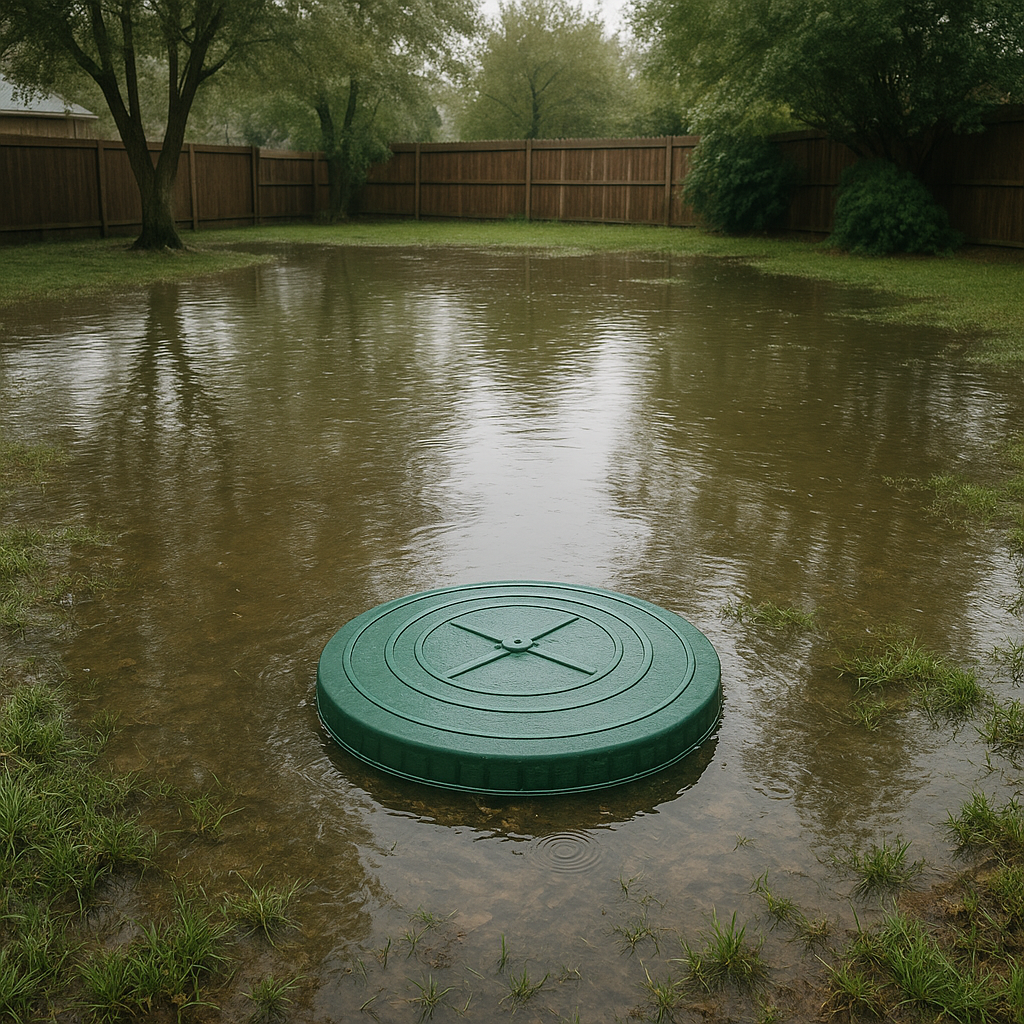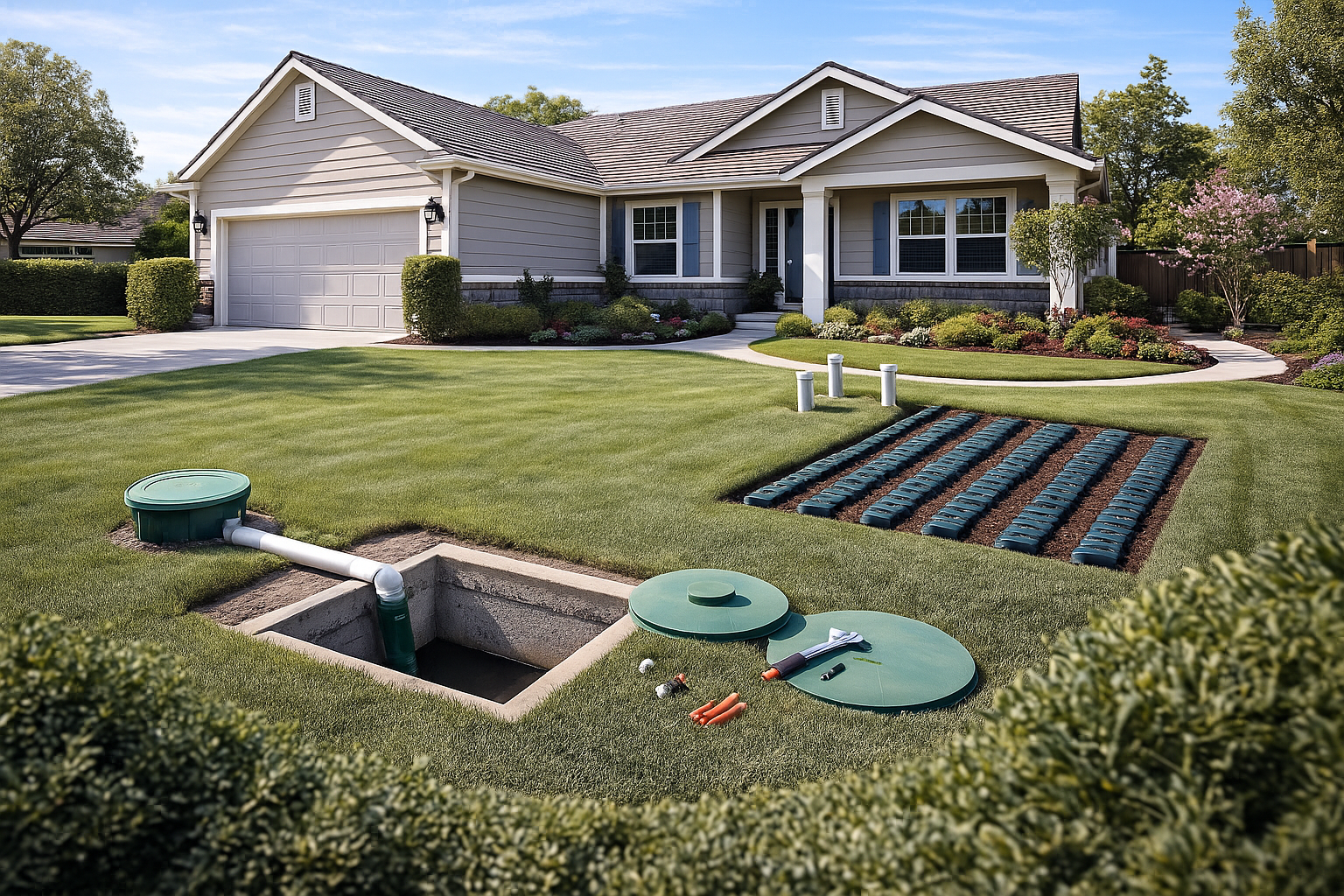Your septic system plays a vital role in treating and managing household wastewater, but it’s particularly vulnerable during periods of heavy rain or flooding. When excessive rainfall saturates the soil around your drain field, it prevents wastewater from being absorbed efficiently, leading to backups, overflow, and contamination. Understanding how to maintain and protect your septic system can save you from expensive septic repair and serious environmental issues.
Heavy rain septic care isn’t just about reacting to problems—it’s about proactive prevention. Performing storm preparation septic checks, such as inspecting your tank, testing for leaks, and ensuring proper grading around your property, can prevent rainwater infiltration. Proper water runoff management and landscaping for septic protection also play an essential role in reducing soil saturation septic issues before they start.
When floodwater reaches your system, flooded septic tank fix services may become necessary to handle overflow or malfunction. However, much of this can be avoided through early inspection and the use of waterproof septic components that improve system resilience. If flooding does occur, ensure a septic inspection after flood events to assess any hidden damage.
To dive deeper into professional recovery methods, check out our detailed guide on emergency septic tank pump out. By following a septic maintenance checklist and adopting groundwater contamination septic prevention practices, your system will remain flood-resistant, reliable, and ready for any storm season.
Preventative Maintenance Before Heavy Rain
Preventative care is the foundation of long-lasting septic health, especially before major storms. The best time to prepare your system is before rainfall begins, by removing buildup and inspecting all system components. Start by scheduling a septic pumping service once every few years, or after a particularly wet season, to prevent sewage overflow and septic backup prevention issues.
Here are practical steps to take before the rainy season:
- Inspect for cracks or leaks: Even small openings allow rainwater into your tank, weakening performance.
- Install a septic riser: Simplify access for inspection and maintenance. Learn how in our guide on the septic tank pump out process.
- Clean the effluent filter: Routine effluent filter cleaning keeps solids from entering your drain field.
- Improve drainage: Use stormwater diversion ideas such as sloped landscaping or drainage swales.
- Add waterproof septic components: These materials help resist infiltration and corrosion.
During heavy rainfall impact on septic systems, avoid overloading your drains. Reduce water usage during and after storms to ease stress on your leach field.
If you’re aiming for added protection, consider flood resistant septic design or sump pump installation septic systems. These minimize damage and improve long-term stability. For everyday care, try these septic system maintenance hacks to keep your system efficient.
By planning early and following a septic maintenance checklist, you’ll minimize the chance of standing water around your tank and protect your investment from unnecessary flooding or groundwater contamination.
Managing Water Runoff and Drainage
Managing water runoff properly is one of the most crucial ways to prevent septic system damage during storms. When drainage is poorly designed, excess rainwater accumulates and saturates the soil, leading to flooded drain fields, septic overflow, and soil saturation septic issues.
To avoid this, focus on creating a landscape that encourages proper water flow:
- Redirect downspouts and gutters: Keep them away from the septic area.
- Use landscaping for septic protection: Grade your yard to slope gently away from the drain field.
- Install gravel trenches or French drains: These help absorb excess stormwater efficiently.
- Avoid compacting soil: Heavy equipment and vehicles reduce permeability.
- Consider sump pump installation septic systems: Ideal for low-lying areas prone to water pooling.
Proper rainwater drainage planning is key to preventing groundwater contamination septic risks. Keep gutters clear of debris, trim vegetation, and ensure storm drains flow freely.
If your system’s location makes it difficult to redirect water naturally, explore drainage system improvement projects, such as protective grading or the addition of waterproof septic components. You can also learn how pump trucks assist in managing excess water and sludge during storms in our article on the septic pump outs pump truck process.
By controlling runoff effectively, you prevent sewage backup after rain, protect groundwater, and extend the lifespan of your septic system. Regular inspections—especially post flood septic inspection—help identify erosion or blockages before they become major repair issues.
Actions to Take During Flooding
When flooding happens, the priority should always be safety. Floodwaters often contain bacteria, sewage, and chemicals that pose serious health risks. During a storm, your septic system is under extreme stress. The key is to minimize water use and prevent further system overload until conditions stabilize.
Follow these essential steps during floods:
- Limit all water usage: Pause dishwashing, showers, and laundry.
- Do not open septic lids: Doing so may allow contaminated floodwater into your tank.
- Avoid flooded areas: Standing water around the tank could conceal hazards.
- Turn off electrical connections: Disconnect power to pumps or alarms during severe weather.
- Monitor for sewage odors: These may signal infiltration or damage.
If the water table is high, there’s an increased storm drain connection risk, which can cause cross-contamination. Should your system begin backing up, don’t attempt a DIY repair—learn more about why in our article on DIY septic tank pump out risks and benefits.
After major flooding, call professionals for an emergency septic repair or flooded septic tank fix. Expert technicians have the tools to handle overflow safely, minimizing further damage.
Practicing storm preparation septic routines before disasters and avoiding heavy water usage during floods will preserve your system’s integrity and prevent costly backup prevention plumbing problems once the storm passes.
Post-Flood Recovery and Inspection
After a flood, your septic system may appear fine on the surface but still be hiding serious problems beneath the ground. Post flood septic inspection is critical for identifying structural damage, infiltration, or soil saturation that could affect long-term performance.
Here’s how to safely restore your system after flooding:
- Wait until the water table drops: Pumping too early can cause the tank to float or collapse.
- Schedule a professional inspection: A licensed septic maintenance service will check for leaks, cracks, and groundwater contamination septic risks.
- Clean and disinfect surfaces: Protect your family from bacteria exposure.
- Repair damaged parts: Replace compromised risers, lids, or filters for improved septic system waterproofing.
- Regrade the soil: Encourage proper drainage to prevent recurring flooding.
Post-storm flood recovery septic cleaning ensures sediment and debris don’t clog your system. Upgrading to flood resistant septic design and using waterproof septic components can strengthen your system’s resilience.
If your system experienced overflow, review the emergency septic tank pump out process for faster recovery and safety steps. Keep a septic maintenance checklist handy to track every inspection, pumping, and repair.
Regular upkeep, including effluent filter cleaning and sump pump installation septic maintenance, ensures your system remains efficient even in future storms. By taking these proactive steps, you’ll reduce the risk of sewage backup after rain and protect both your property and local environment.






